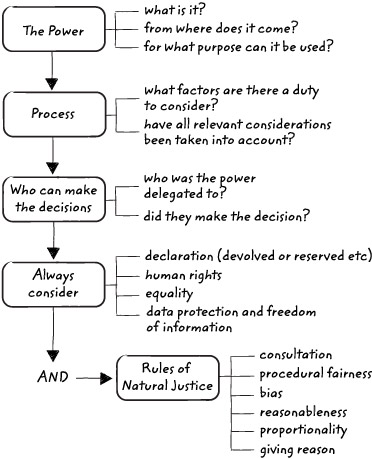7 Bringing this all together
You have learnt about how decisions should be made and the grounds on which they may be challenged. The materials you have encountered this week may have appeared drier in their tone and approach and there has been a lot to take in. Figure 4 provides an example summary of the sort of steps that may be used in considering whether it is possible to bring a case against a decision made by a public body.

You should now listen to the audio in which two OU Law School academics discuss judicial review and then attempt Activity1 which provides an opportunity for you to try out what you have learnt during your studies of this week.
Activity 1 The decision-making process and challenges
Read the following scenarios. Based on the knowledge gained from this week of study, reach a conclusion in each case. Provide a reason for your conclusion.
- A senior police officer is dismissed from their post. They are not given reasons for their dismissal and they are given no prior notice of their dismissal. They have not been accused of any misconduct and have an exemplary record.
- The local authority has a delegated legal power to make regulations in respect of charges for parking in public car parks. They have issued a notice which takes effect in seven days that in future all residents in the town will need to pay for parking permits for any car or other vehicle they park on a publically owned road. The permits are going to cost £1,000. The reason given for the decision was to make more parking available for visitors (who will park for free).
Comment
Identifying issues and finding solutions is key to the work of many solicitors and advocates. Good problem-solving and communication skills are developed by the study of law and legal systems and are at the heart of legal work. It is one of the reasons why the skills developed during study of a law degree are regarded as so transferable.
When approaching legal problems, it is important to take a logical approach. One approach that is commonly taken is to identify the issue, what rule has been broken, what the evidence is and what conclusion should follow. This is sometimes referred to as IRAC (Issue, Rule, Application and Conclusion). This was illustrated in Figure 5 Week 5 [Tip: hold Ctrl and click a link to open it in a new tab. (Hide tip)] .
Question 1
Issue – Is an administrative decision properly made by a public authority? Was the correct and fair procedure followed to determine he dismissal of the senior police officer?
Rule – Police forces fall within the definition of public body, Administrative decisions of public bodies must be made following the correct procedure and the person affected must be given a fair hearing. The deciding authority ought to give reasons for their decision.
Application – The rules of procedural fairness were not applied here as the senior officer was not informed of the procedure in advance, was not given the opportunity to hear the grounds for the decision against them and were not given the opportunity to present a case before the decision was made. At no point where they able to object to the decision. Also, the senior police officer was not told of the reasons for the decision when they should have been.
Conclusion – The way in which the decision to dismiss the senior officer was made was procedurally unfair and should be reviewed.
Question 2
Issue –The issue is whether the local authority went outside the powers granted to it by the primary legislation and if so, was the decision make a reasonable and/or proportion one. To be proportionate the short notice and £1000 cost of the permit must be the most effective way of achieving the result sought.
Rule – The powers of local authority have been delegated to it by primary legislation. In exercising those delegated powers the local authority must to act in a way which does not exceed those power. The local authority must also act reasonably and in a way that is proportionate to the ends it wishes to achieve. It should also consult affected groups before making such decisions.
Application – This is an administrative decision by a public authority (the local authority) which has been made under its delegated powers. We are not given information on whether the local authority had power to make such extreme rules. Assuming it has, the goal to be achieved was to create free parking for visitors to the town. In order to achieve that goal the local authority has imposed regulation both at short notice to obtain permits and which are very expensive. Providing free parking for visitor could have been achieved through less expensive and less intrusive means. The residents were of the town were not consulted on whether this was the best way of providing free parking for visitors.
Conclusion – In making the decision the local authority acted in a way that was not legal as it passed regulation without consultation and that were punitive and disproportionate.
